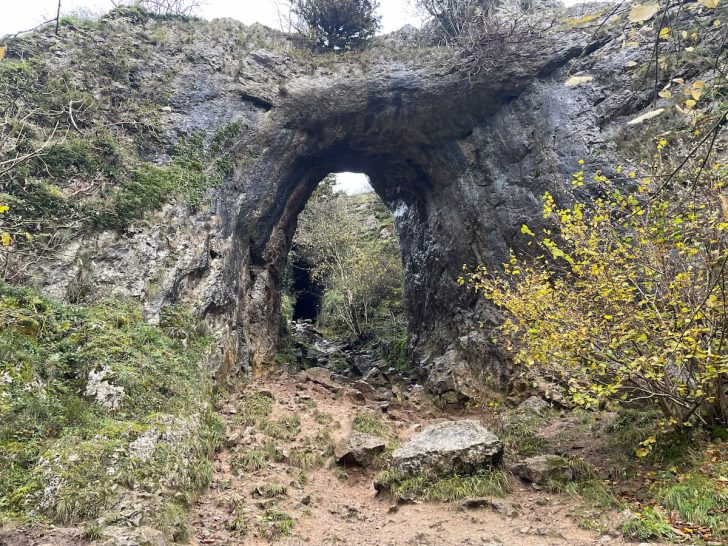Peak District Caves and Caverns are renowned for their unique and exceptional underground scenes, attracting visitors from all over the UK.
Boasting a range from deep, shadowy caverns to cosy, porthole-like nooks, this guide has something to suit everyone’s tastes.
In this article, we will explore the top caves and also provide a comprehensive list of all known caves in the Peaks.
Famous Peak District Caverns & Caves
While there are too many caves to cover in great detail, we can highlight some of the most popular ones for you.
Exploring the numerous caves and caverns within the Peak District offers a fun family day out near Manchester, ensuring the children are both entertained and educated and their curiosity sparked.
Here are some of the top picks, both free and paid:
1. Thor’s Cave

Address: Manifold Valley, Peak District National Park
Entry: Free
Thor’s Cave, a standout attraction in the Peak District, mesmerizes visitors with its breathtaking views from within, perched high on a crag.
Situated close to the Manifold Way, it’s a perfect spot to combine a delightful walk with an exploration of the cave’s interior.
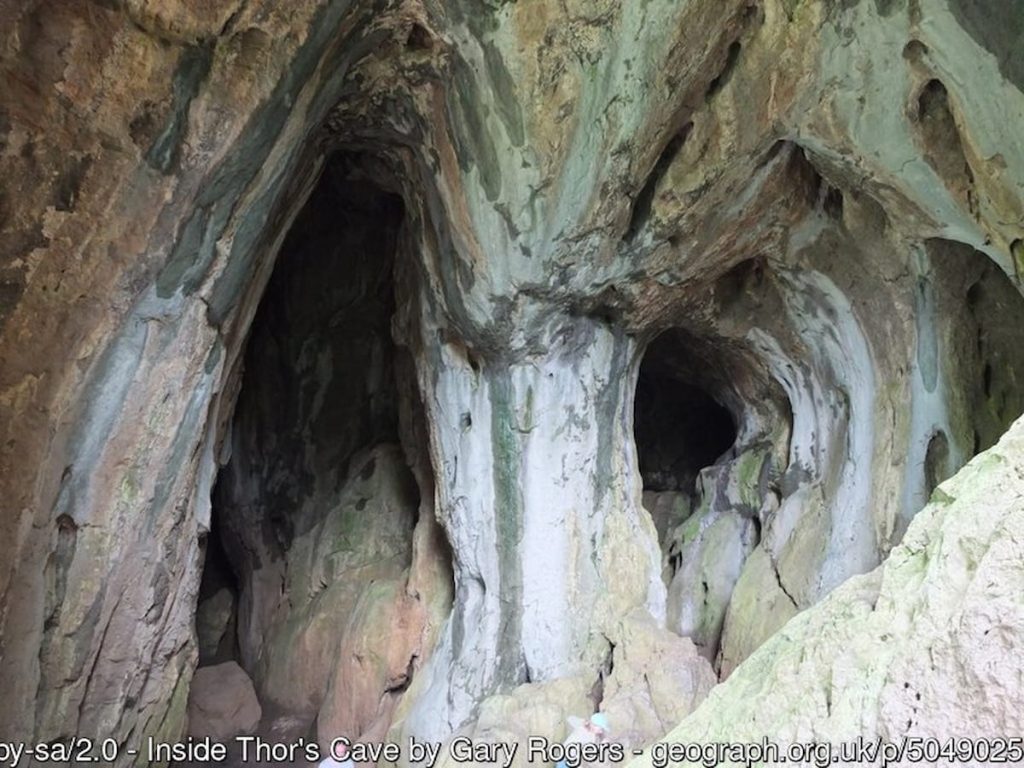
This cave isn’t just celebrated for its stunning beauty; it’s also a magnet for climbers and history buffs. Evidence suggests it was used as far back as the Palaeolithic age, adding a rich historical layer to its appeal.
Check out the Thor’s Cave Walk
2. Poole’s Cavern
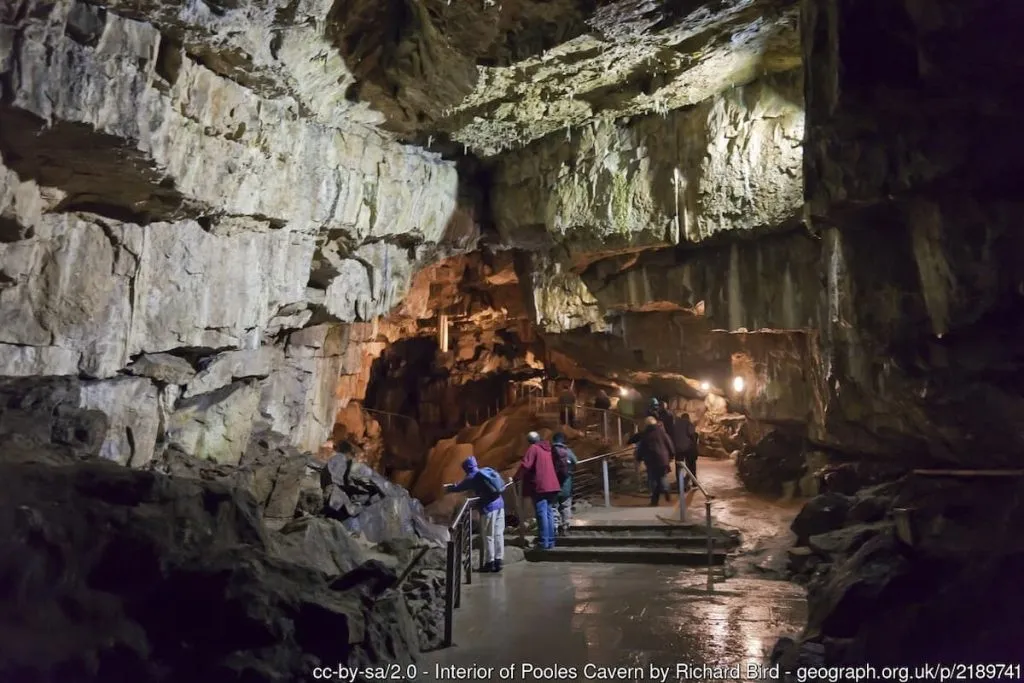
Address: Green Ln, Buxton SK17 9DH
Entry: £7.5-£17
Poole’s Cavern, a two-million-year-old natural limestone cave, once closed to the public for over a decade, was revived by the Buxton Civic Association in 1977. This reopening brought its underground wonders back to public attention.
As visitors enter, they are met with impressive stalactites and stalagmites. Highlights include the playfully named “Flitch of Bacon” and the historically significant “Mary Queen of Scots’ Pillar”.
Unique to this cavern are stalagmites with a distinctive “poached egg” colour and texture, resulting from minerals leaking from lime-burning on the Grin Low and Solomon’s Temple above.
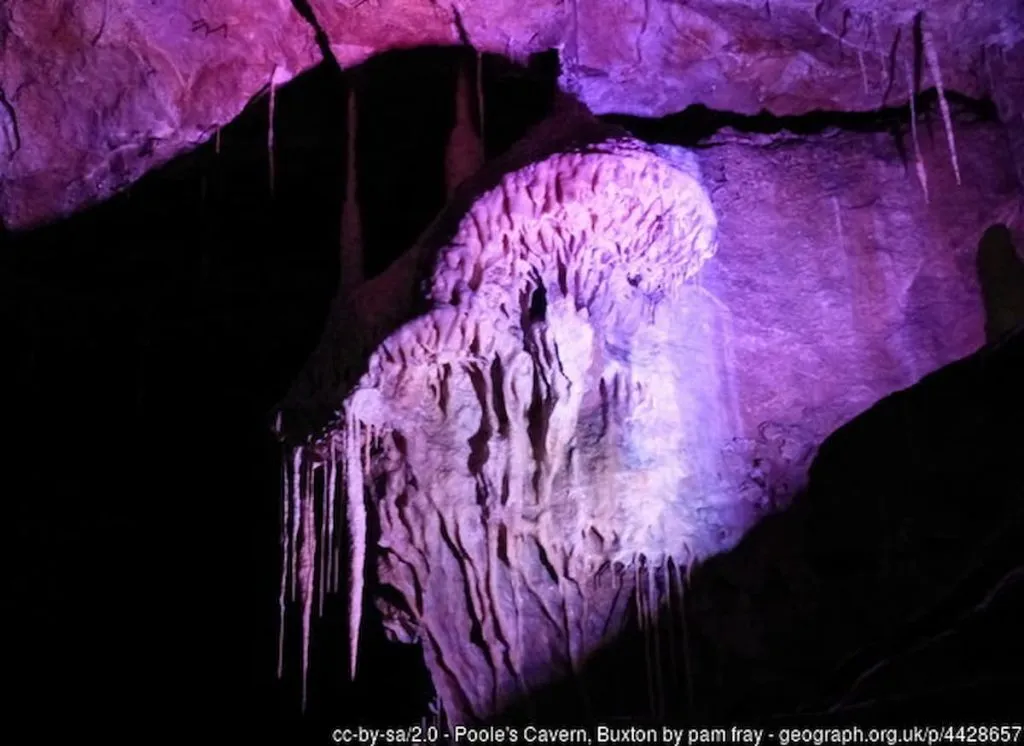
During the 30-minute tour, visitors can explore around 310 metres (1,020 ft) of the cavern, though it’s believed to stretch even further beyond this known area.
3. Peak Cavern (The devil’s 🍑)
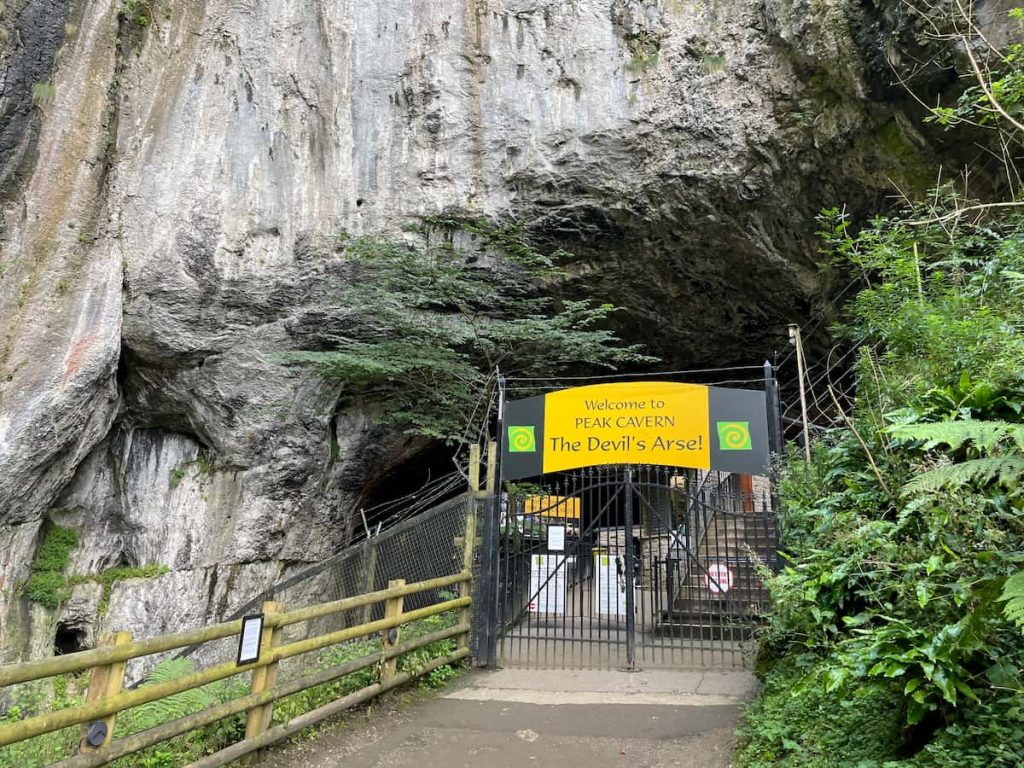
Address: Peak Cavern, Castleton, Hope Valley, S33 8WS (///what.three.words)
Entry: £11-18.75
Peak Cavern, often referred to as the Devil’s Arse, has a rich and diverse history.
This site was once home to Britain’s last troglodytes and served as a hideout for bandits and thieves, adding a layer of intrigue to its vast chambers.
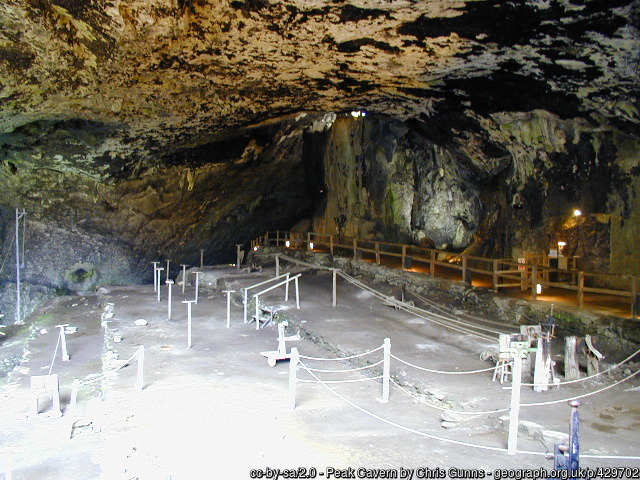
Peak Cavern is one of three main show caves in the area and is conveniently just a 5-10 minute walk from the village of Castleton.
Guided tours last between 60-75 minutes and start every hour from 10 am to 4 pm during summer. Dogs on short leads are welcome, but wheelchairs and pushchairs can’t go beyond the entrance. There are no toilets at the cavern, but facilities are available in the village car park.
Admission Prices:
- Adults: £18.75
- Children: £11.00
Remember, the cavern’s temperature is around 8°C, so it’s advised to wear warm, waterproof clothing and sturdy footwear.
4. Treak Cliff Cavern
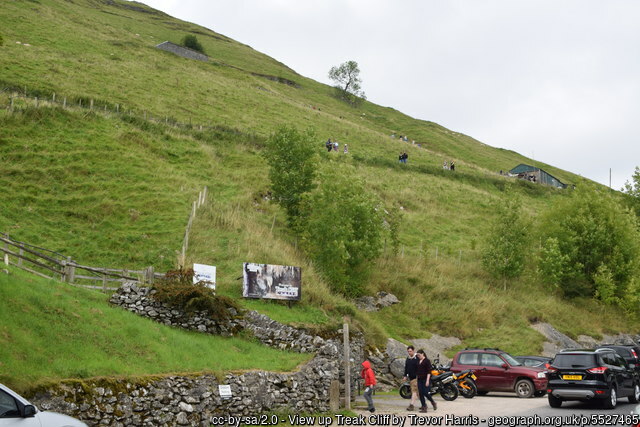
Address: Treak Cliff Cavern, Cross Street, Castleton, Hope Valley, S33 8WH
Entry: £6.50-£14.50
Treak Cliff is renowned for its stunning stalactites and stalagmites, including the enchanting Fairyland and the imposing Dome of St Pauls.
Its geological importance is underlined by the presence of Blue John Stone veins, making it a site of special scientific interest.
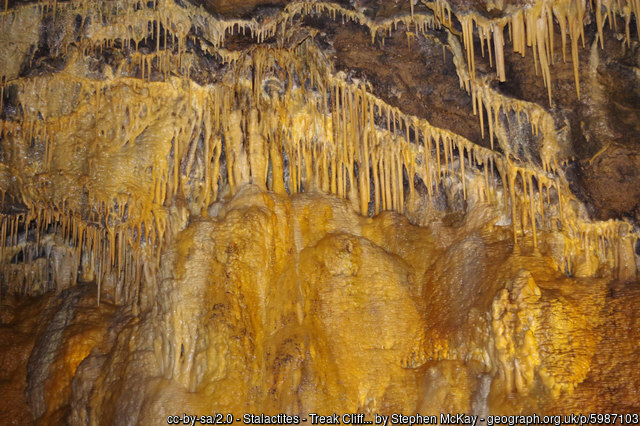
- The cave isn’t suitable for wheelchairs or prams, but those with walking disabilities can visit.
- Dogs are welcome on leads.
- An on-site cafe is open from 10 am to 4 pm.
Admissions:
- Adults: £14.50, Early Bird Online: £11.50
- Students (with ID): £11, Early Bird Online: £9
- Children (5-17 years): £8, Early Bird Online: £6.50
- Under 5s: Free
Note: The Early Bird discount is available online-only, for visits before 10:55 am
5. Reynard’s Cave

Reynard’s Cave in Derbyshire’s Dovedale Gorge offers a unique experience with its steep climb to the entrance.
Once you reach the top, you can explore Reynard’s kitchen and an adjacent cave, which both offer fantastic views of the gorge below, the site of the cave’s original entrance.
The cave’s name has intriguing origins steeped in local lore. It’s thought to be named after a local outlaw, Reynard, who supposedly used it as a hideout. Alternatively, it could be linked to its use by foxes, drawing a connection to the medieval tale of Reynard the Fox.
To fully experience Reynard’s Cave and the surrounding Dovedale valley, consider the full Reynard’s Cave walk. This route also includes other notable sights like the Dovedale Stepping Stones and Thorpe Cloud.
6. Dove Holes Cave

A little further down the river from Reynard’s Cave, you’ll find Dove Holes Cave. Unlike Reynard’s Cave, it is shallower and easier to explore.
You can reach it by following the Dovedale walking route.
7. Robin Hoods Cave
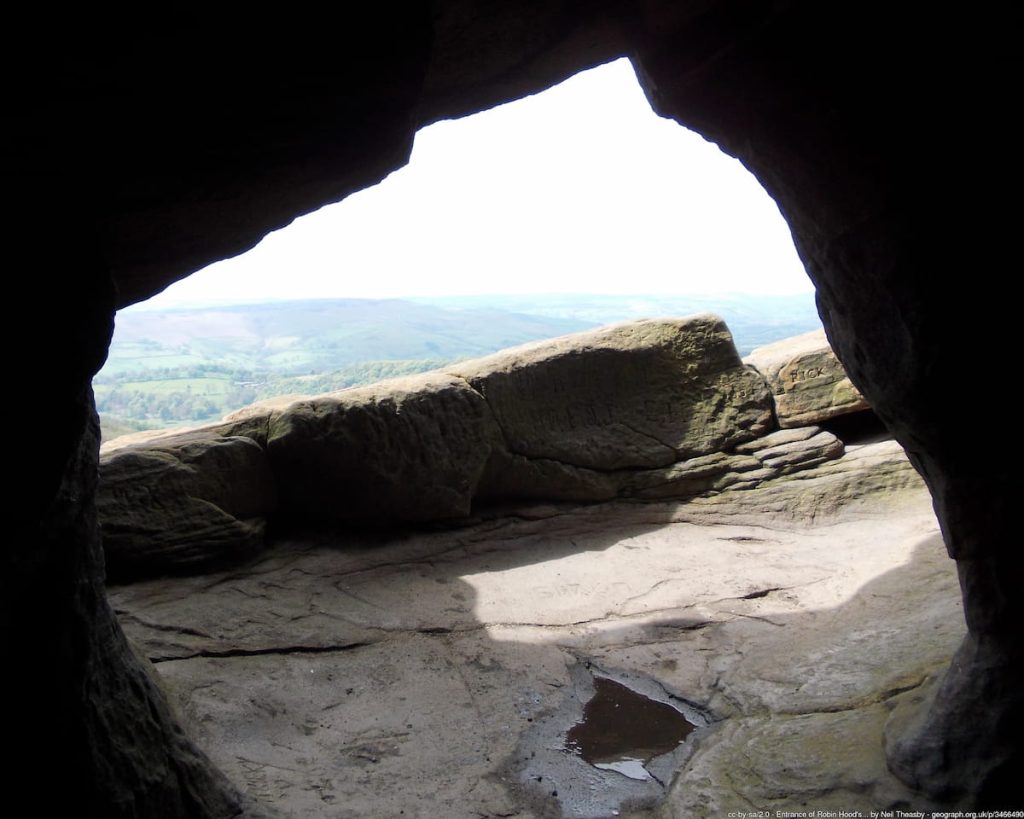
Robin Hood’s Cave, nestled in the scenic Stanage Edge, is a fascinating spot wrapped in legend.
As the supposed hideout of the legendary outlaw Robin Hood, this secluded cave is somewhat challenging to locate and reach. It requires a walk across the moors and a bit of a scramble down to the cave itself. But once you’re there, the reward is stunning countryside views.
This area is particularly popular among hikers and climbers. It’s steeped in history and surrounded by myths about Robin Hood and his Merry Men, creating a captivating blend of natural beauty and intriguing folklore.
8. Blue John Cavern
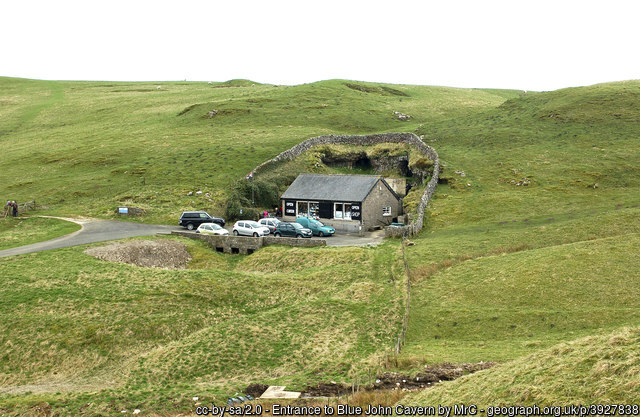
Address: The Blue John Cavern, Castleton, Hope Valley, S33 8WP
Entry: £11-£18
Blue John Cavern is celebrated for its abundant Blue John Stone, a beautiful mineral mined for centuries.
Visitors can experience a unique combination of natural splendour and a glimpse into the cavern’s mining past, including ongoing mining operations.
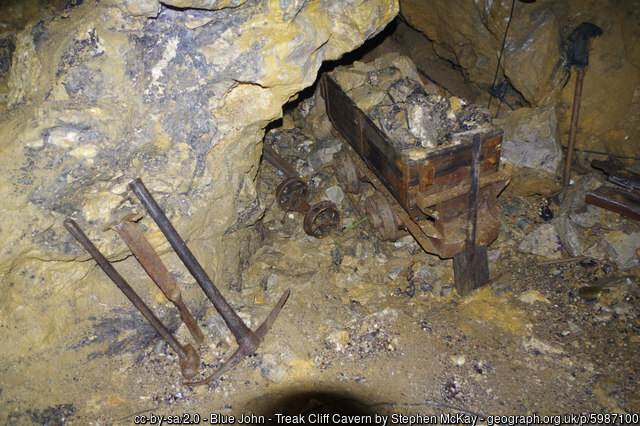
Tours typically last from 50 minutes to an hour, with groups descending every 45 to 50 minutes.
Admission Fees:
- Adults: £18.00
- Children (5-15 years): £11.00
- Senior Citizens & Students: £15.00
- Family Ticket (2 adults & 2 children): £50.00
- Group and school rates are available, but booking is necessary.
Note: The Blue John Cavern has 245 steps to navigate, both descending and ascending, so appropriate footwear is advised.
Full list of Peak District Caves and Caverns
| Cave | Depth (m) |
| Bagshawe Cavern | 75 |
| Blue John Cavern | 90 |
| Carlswark Cavern | 60 |
| Cratcliff Rocks hermitage | Unknown |
| Cumberland Cavern | 0 |
| Devonshire Cavern | 80 |
| Dowel Cave | 0 |
| Dream Cave | 15 |
| Dove Holes | 0 |
| Elderbush Cave | Unknown |
| Eldon Hole | 85 |
| Fox Hole Cave | 0 |
| Gautries Cave | 26 |
| Giant’s Hole | 140 |
| Great Masson Cavern | 0 |
| Great Rutland Cavern | 0 |
| Harboro’ Cave | 0 |
| Jug Holes | 0 |
| Lathkill Dale Head Cave | 55 |
| Merlin’s Mine | 30 |
| Nettle Pot | 174 |
| Odin Cave | 0 |
| Ossom’s Cave | Unknown |
| Oxlow Cavern | 145 |
| P8 | 0 |
| Peak Cavern | 130 |
| Plunge Hole | 15 |
| Poole’s Cavern | 0 |
| Reynard’s Cave | 0 |
| Rowter Hole | 182 |
| Speedwell Cavern | 235 |
| S*icide Cave | 27 |
| Thirst House Cave | 0 |
| Thor’s Cave | 0 |
| Titan | 196 |
| Treak Cliff Cavern | 0 |
| Winnats Head Cave | 148 |
| Robin Hoods Cave | 0 |
| The Hidden Druids Caves | 0 |
*Great Rutland and Masson Cavern can be visited next to the heights of Abraham in Matlock. One of the top things to do in Matlock Bath.
FAQs for Caves in the Peak District
Where is the best mine to visit in the Peak District?
Blue John Cavern is often regarded as the best mine to visit in the Peak District.
It’s famous for its rare Blue John stone, a type of fluorspar with beautiful purple and blue hues. Guided tours are available, showcasing impressive mineral formations and the history of mining in the region.
What are the 4 show caves in Castleton?
Castleton is home to four show caves: Blue John Cavern, known for its Blue John stone; Peak Cavern, also known as the Devil’s Arse, with a large cave entrance; Speedwell Cavern, featuring underground boat trips; and Treak Cliff Cavern, another source of Blue John stone.
What do they mine in the Peak District?
The Peak District has a rich mining history, primarily involving lead, fluorspar, and barytes. It’s also famous for its Blue John stone, a unique and beautiful mineral.
These resources played a significant role in the area’s industrial history.
Which is the deepest cave in the Peak District?
Titan Cave holds the record as the deepest cave in the Peak District. It features the UK’s largest natural shaft, plunging approximately 141 meters deep.
Titan Cave offers a remarkable subterranean landscape, but due to its depth and complexity, it’s more suited for experienced cavers.
Can you visit Titan Cave?
Titan Cave, the largest shaft in the UK, can be visited, but it requires special arrangements and is not typically open to the general public.
It’s a site for experienced cavers and researchers, offering a unique underground experience.

